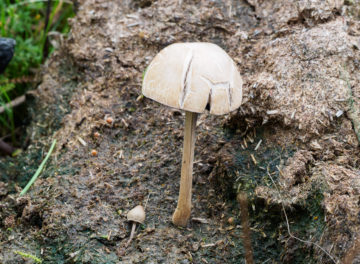The place on the Common which I head for at this time of year, camera in hand, is Shirlaw Woods, where the fungi are enthusiastically throwing up their fruitbodies. These things are a joy to photograph, they stay still and mostly they don’t blow about in the wind. This is a good time to point out that I have neither the microscope nor the knowledge to accurately identify the majority of fungi I find. Sometimes the species is obvious, sometimes I can get it down to family, but often they remain a mystery, and I am happy to be corrected on any of my id’s.
Right next to the entrance gate, pushing up through the gravel of the forestry road, was this lovely Orange Peel (Aleuria aurantia), common according to the books, but one I rarely see I up here.

Orange Peel
Lining the sides of the road are scores of False Chanterelles (Hygrophoropsis aurantiaca), which abound in the woodland on these moors. Several years ago I was told by a local chef that he collected Chanterelles from this very spot. I have never seen a Chanterelle here; maybe I’ve just not seen them, but this chap never did get his Michelin Star. He’s left the area now.

False Chanterelle
Feeling adventurous, farther up the road I decided to launch off northwards into the forest, normally a stupid thing to do but this was along a stream so not even I could get lost. In the narrow clearing by the stream I was rewarded with fine collections of Milkcaps, only one of which I managed to put a name to – the fiery hot Rufous Milkcap (Lactarius rufus), and a couple of perfect little Galerinas nestling amongst the moss & heather.

Rufous Milkcap
I soon came out of the forest onto the moor, and headed back to the car across the rough dried up bogland. The moor is still very dry, wetland plants have had a tough year here. What should have been just an awkward bog-trot across the moor was now a nightmare of rock hard mounds and holes; ankle-twisting, leg-snapping stuff if you aren’t careful. There were few fungi around, but the cattle had been leaving their pats behind which provided habitat for Mottlegills (Panaeolus), this one is Egg-head Mottlegill I think (P. semiovatus)

Egg-head Mottlegill
By John Dalrymple